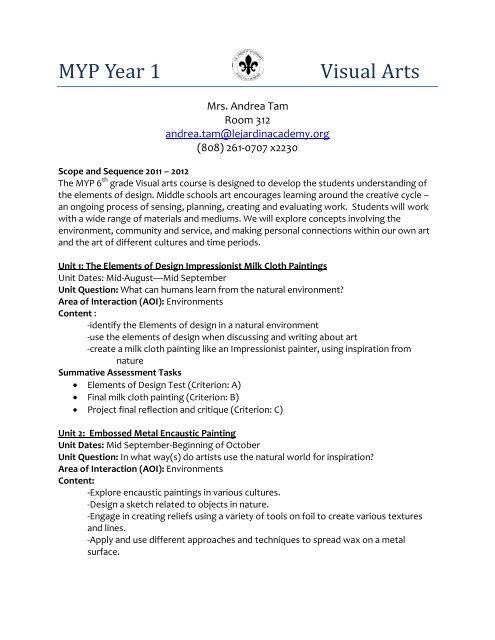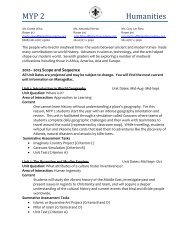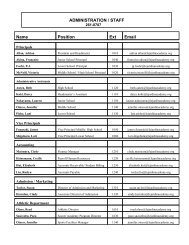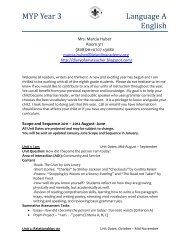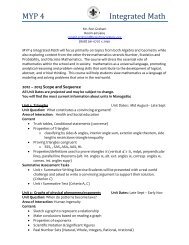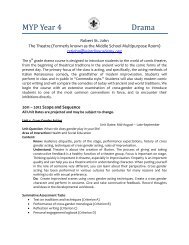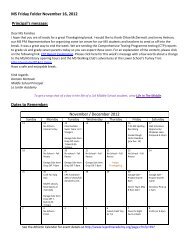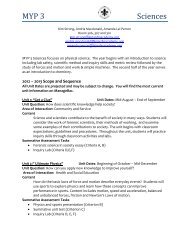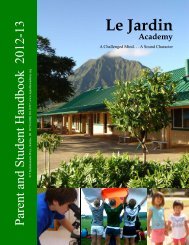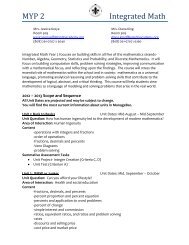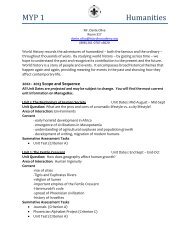MYP Year 1 Visual Arts - Le Jardin Academy
MYP Year 1 Visual Arts - Le Jardin Academy
MYP Year 1 Visual Arts - Le Jardin Academy
- No tags were found...
You also want an ePaper? Increase the reach of your titles
YUMPU automatically turns print PDFs into web optimized ePapers that Google loves.
<strong>MYP</strong> <strong>Year</strong> 1<strong>Visual</strong> <strong>Arts</strong>Mrs. Andrea TamRoom 312andrea.tam@lejardinacademy.org(808) 261-0707 x2230Scope and Sequence 2011 – 2012The <strong>MYP</strong> 6 th grade <strong>Visual</strong> arts course is designed to develop the students understanding ofthe elements of design. Middle schools art encourages learning around the creative cycle –an ongoing process of sensing, planning, creating and evaluating work. Students will workwith a wide range of materials and mediums. We will explore concepts involving theenvironment, community and service, and making personal connections within our own artand the art of different cultures and time periods.Unit 1: The Elements of Design Impressionist Milk Cloth PaintingsUnit Dates: Mid-August—Mid SeptemberUnit Question: What can humans learn from the natural environment?Area of Interaction (AOI): EnvironmentsContent :-identify the Elements of design in a natural environment-use the elements of design when discussing and writing about art-create a milk cloth painting like an Impressionist painter, using inspiration fromnatureSummative Assessment Tasks Elements of Design Test (Criterion: A) Final milk cloth painting (Criterion: B) Project final reflection and critique (Criterion: C)Unit 2: Embossed Metal Encaustic PaintingUnit Dates: Mid September-Beginning of OctoberUnit Question: In what way(s) do artists use the natural world for inspiration?Area of Interaction (AOI): EnvironmentsContent:-Explore encaustic paintings in various cultures.-Design a sketch related to objects in nature.-Engage in creating reliefs using a variety of tools on foil to create various texturesand lines.-Apply and use different approaches and techniques to spread wax on a metalsurface.
Summative Assessments Task-Final Project-Creating an Embossed metal Encaustic painting. (Criterion: B)-Project final reflection and critique (Criterion: C)Unit 2: Hawaiian Animal OcarinasUnit Dates: Beginning of October –End of OctoberUnit Question: Why/how do systems, solutions and products develop and change over time?Area of Interaction (AOI): Human IngenuityContent:-create a clay flute that produces sound-learn clay techniques and art terminology-create texture with clay-understand how inventions of the past have developed and changed over time-understand the history of the “Ocarina”-incorporate part of the culture of living in Hawaii into a piece of artSummative Assessment Tasks Final studio project of glazed clay ocarina with sound (Criterion: B) Project Final Reflection and critique (Criterion: C) Ocarina Personal Engagement (Criterion: D)Unit 3: Giacometti Inspirational Sign SculptureUnit Dates: End of October to Mid NovemberUnit Question: How do signs we see everyday have an effect on ourselves and ourcommunity?Area of Interaction- (AOI) :Community and serviceContent:-Explain the difference between and art movement, art genre and art form-Create a figurative sculpture in the style of Alberto Giacometti using wire, foam andplaster of Paris-Create and inspirational sign that will have a positive effect on the environment it isinstalled in.-Create a 3-D sculpture that works from multiple angles-Install artwork in a in a specific setting to have a positive influence on the viewerexperiences the space.Summative Assessments Task:-Art Movement, Genre and Form Summative Quiz (Criterion A)-Giacometti Sculpture with Sign (Criterion B)-Project Reflection (Criterion C)-Personal Engagement Reflection (Criterion D)
Unit 4: Pastel Stuffed Animal: Making Personal Connection in ArtUnit dates: Mid November-DecemberUnit Question: How do past experiences limit or enhance our ability to learn and understandour world?Area of Interaction (AOI): Approaches to <strong>Le</strong>arningContent:-create accurate representations of objects in their drawing by breaking things downinto basic shapes-use observational drawing skills to draw stuffed animal-create texture using pastels-use warm and cool colors to create highlights and shadows-develop a sense of connection to one’s art by creating an image of a personal objectSummative Assessment Tasks Final still life project (Criterion: B) Project reflection and critique (Criterion: C) Personal Engagement Reflection (Criterion: D)


